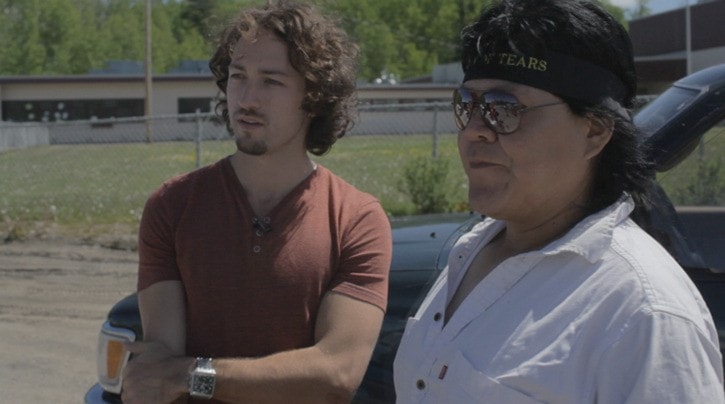A film about the Highway of Tears has won the Best Documentary accolade at the Malibu Film Festival on Saturday, just days after the B.C. government released its final update report on improving the notorious stretch of Highway 16.
Highway of Tears, a film by L.A.-based director Matt Smiley and producer Carly Pope, has been screened a handful of times since it premiered at the TIFF Human Rights Watch Film Festival in Toronto in March.
Through interviews with family members of victims, First Nations leaders and the RCMP, the film tackles the connection between missing Aboriginal women and issues such as generational poverty, residential schools, systemic violence and high unemployment rates in reserves.
Rather than graphically retelling what happened to the victims, Smiley said the finished film aimed to provide a platform for people connected to the Highway of Tears to tell their stories.
The director also wanted to give a voice to some of the powerful women in the affected communities.
He said a lot of people at the screenings had been shocked because they had not heard of the Highway of Tears.
“Especially here in Los Angeles, we did one private screening but still people were like, we always think of Canada as this super safe place,” he said.
“To a certain degree it is, but when you start diving deep into some of these issues, especially with regards to transportation, poverty or going to visit some of these First Nations reservations, you start to quickly realize some of the dangers that not only the young women live with but the young men as well.”
Smiley, who is originally from Montreal, was on a family trip to northern B.C. when he first heard about the disappearances along the Highway of Tears.
Around a campfire in the wilderness outside Prince George, Smiley heard how 25-year-old tree planter Nicole Hoar was hitchhiking from Prince George to Smithers when she vanished in 2002.
Moved by her story, Smiley, who has a background in commercial film and television, returned to L.A. with an idea for a feature film about a family’s struggle to find their daughter.
He started to piece together more information about the Highway of Tears and contacted family members of the missing and murdered women to find out more.
But a few phone calls later, Smiley had abandoned his fiction concept.
“I had thought of a fiction film that I wanted to do out there and the more I started to research, there was really an immediate shift when I spoke to two or three family members,” he said.
“I’d never had an intention of making a documentary film but there was sort of a necessity that people would know about this.”
He met with his co-producer Carly Pope and started planning a three-week filming trip to northern B.C.
Before he returned with a crew, the director embarked on a solo trip to meet some of the family members of victims.
Smiley’s vision for the film was to let the story unfold “organically” through interviews.
“As far as my vision the most important part was trying to dig into the root causes of the issue,” he said.
“I think there will always be, sadly, murders and violence among ourselves but that huge disconnect as far as the sheer number of missing and murdered women, especially just in the North, was the nucleus of where I started and it’s definitely grown from there.”
As he became closer to the issue, Smiley was increasingly driven to raise awareness about the Highway of Tears.
Smiley said the reaction from First Nations representatives who had seen the film, including activist Gladys Radek whose niece disappeared on the Highway of Tears, had been positive to date.
He said he hadn’t anticipated how much impact the film would have in highlighting the issue of missing and murdered women in Canada.
“I went into this whole experience in a very naive fashion,” he said.
“I’ve always worked whether it be with commercials or acting or working with other directors on bigger motion pictures but I’d never really worked with, I would say, a cause.
“I didn’t really realize, although I went in with my heart, that it would actually make people pay attention to it ... I’m very surprised at how it’s starting to bring people together.”
Last week the B.C. government released its final report on its progress implementing 56 recommendations of the Missing Women Commission Inquiry.
Better transportation along Highway 16 is discussed in the report, although it does not include a commitment to a shuttle service, which has been widely called for by relevant parties.
Smiley said transportation was just one element of what was needed to improve safety along the Highway of Tears and beyond.
He is also supporting the push for a national inquiry into missing and murdered Aboriginal women in Canada.
“There does need to be some sort of continued investigation by an independent group to continue finding obviously the names of missing and murdered women that are not documented and to keep ourselves in check to make sure there is proper education for the young women, especially with regards to transportation and safety, and to build more awareness,” he said.
“I think my biggest challenge to tackle is, with regards to the national inquiry, is getting all the various different First Nations and non-First Nations and non-government groups to all agree to the right action plan and for everybody to work together.”
To view the provincial government’s report, visit www.ag.gov.bc.ca/public_inquiries.
For more information about the film visit www.highwayoftearsfilm.com.
